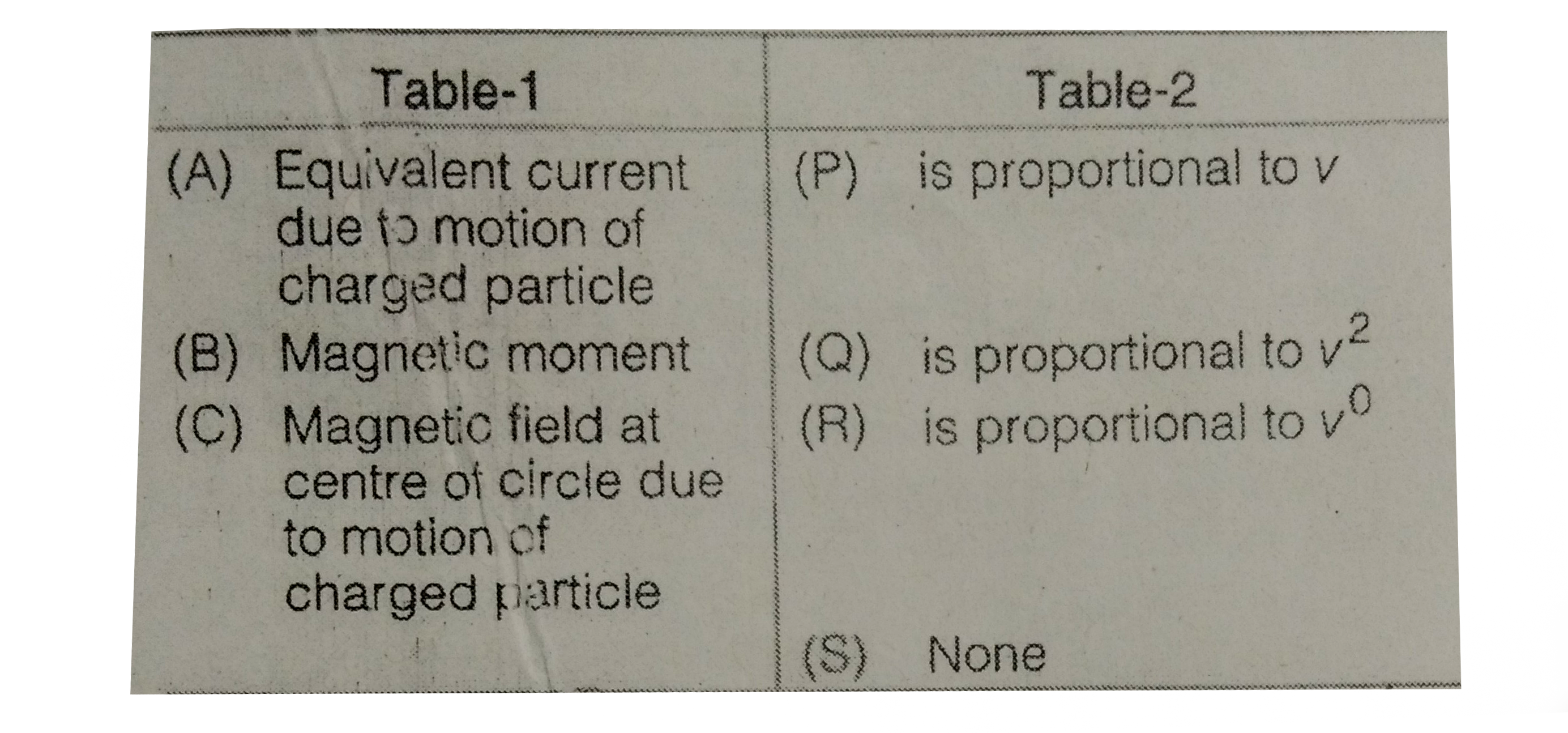A charged particle(q) is projected perpendicular to a uniform magnetic field (B) with speed u. A is the area bounded by the path followed by electrons. K is kinetic energy of the particle. Then how will the graph between A and K be?
Straight line
Parabola
Ellipse
None of these
The correct Answer is:a
To solve the problem, we need to analyze the relationship between the area A bounded by the path of a charged particle moving in a magnetic field and its kinetic energy K.
1. Understanding the Motion of the Charged Particle:
- A charged particle with charge q and mass m is projected perpendicular to a uniform magnetic field B with speed u.
- The magnetic force acting on the particle is given by F=q(v×B). Since the velocity v is perpendicular to the magnetic field B, the magnitude of the magnetic force is F=qBu.
2. Centripetal Force and Radius of Circular Path:
- The magnetic force acts as the centripetal force that keeps the particle in circular motion. Thus, we can equate the magnetic force to the centripetal force:
F=mv2r
- Setting the forces equal gives:
qBu=mv2r
- Rearranging this equation to find the radius r:
r=mvqB
- Substituting v=u (the initial speed of the particle):
r=muqB
3. Calculating the Area A:
- The area A bounded by the circular path of the particle is given by the formula for the area of a circle:
A=πr2
- Substituting the expression for r:
A=π(muqB)2=πm2u2q2B2
4. Relating Area A to Kinetic Energy K:
- The kinetic energy K of the particle is given by:
K=12mu2
- We can express u2 in terms of K:
u2=2Km
- Substituting u2 back into the equation for A:
A=πm2q2B2⋅2Km=2πmq2B2K
5. Conclusion on the Relationship:
- The relationship between area A and kinetic energy K can be expressed as:
A=(2πmq2B2)K
- This indicates a linear relationship between A and K (i.e., A is directly proportional to K).
- Therefore, the graph between area A and kinetic energy K will be a straight line.
Final Answer:
The graph between area A and kinetic energy K is a straight line.
- A charged particle with charge q and mass m is projected perpendicular to a uniform magnetic field B with speed u.
- The magnetic force acting on the particle is given by F=q(v×B). Since the velocity v is perpendicular to the magnetic field B, the magnitude of the magnetic force is F=qBu.
- The magnetic force acts as the centripetal force that keeps the particle in circular motion. Thus, we can equate the magnetic force to the centripetal force:
F=mv2r
- Setting the forces equal gives:
qBu=mv2r
- Rearranging this equation to find the radius r:
r=mvqB
- Substituting v=u (the initial speed of the particle):
r=muqB
- The area A bounded by the circular path of the particle is given by the formula for the area of a circle:
A=πr2
- Substituting the expression for r:
A=π(muqB)2=πm2u2q2B2
- The kinetic energy K of the particle is given by:
K=12mu2
- We can express u2 in terms of K:
u2=2Km
- Substituting u2 back into the equation for A:
A=πm2q2B2⋅2Km=2πmq2B2K
- The relationship between area A and kinetic energy K can be expressed as:
A=(2πmq2B2)K
- This indicates a linear relationship between A and K (i.e., A is directly proportional to K).
- Therefore, the graph between area A and kinetic energy K will be a straight line.
The graph between area A and kinetic energy K is a straight line.
Topper's Solved these Questions
- BOOK - MODERN PUBLICATIONCHAPTER - MOVING CHARGES AND MAGNETISMEXERCISE - COMPETITION FILE (B. MULTIPLE CHOICE QUESTIONS)79videos
MOVING CHARGES AND MAGNETISM
- BOOK - MODERN PUBLICATIONCHAPTER - MOVING CHARGES AND MAGNETISMEXERCISE - COMPETITION FILE (C. MULTIPLE CHOICE QUESTIONS)28videos
MOVING CHARGES AND MAGNETISM
- BOOK - MODERN PUBLICATIONCHAPTER - MOVING CHARGES AND MAGNETISMEXERCISE - Revision Exercises (Numerical Problems )18videos
MOVING CHARGES AND MAGNETISM
- BOOK - MODERN PUBLICATIONCHAPTER - MAGNETISM AND MATTEREXERCISE - CHAPTER PRACTICE TEST FOR BOARD EXAMINATION16videos
MAGNETISM AND MATTER
- BOOK - MODERN PUBLICATIONCHAPTER - NUCLEIEXERCISE - CHAPTER PRACTICE TEST FOR BOARD EXAMINATION15videos
NUCLEI
Similar Questions
A charged particle is projected perpendicular to a uniform magnetic field. Describe area bounded by the path of particle inside magnetic field, in terms of its kinetic energy.
View SolutionA charged particle is projected at a very high speed perpendicular to a uniform magnetic field . The particle will
View Solution
Knowledge Check
- Question 1 - Select One
If a charged particle enters perpendicular in the uniform magnetic field then
AEnergy remains constant but moment changesBEnergy and momentum both remains constantCMomentum remains constant but energy changesDNeither energy nor momentum remains constant - Question 2 - Select One
A charge particle is moving in a plane perpendicular to uniform magnetic field, then
AIts momentum changes but kinetic energy remains the sameBBoth momentum and kinetic energy remain the sameCBoth will changeDKinetic energy change but momentum remains the same - Question 3 - Select One
If a charged particle is a plane perpendicular to a uniform magnetic field with a time period T Then
AT2∝r3BT2∝rCT∝r2DT∝r0
A particle is projected in a plane perpendicular to a uniform magnetic field. The area bounded by the path described by the particle is proportional to
View SolutionA charged particle is moving in a circular path in uniform magnetic field. Match the following.
 View Solution
View SolutionWhat will be the path of a charged particle moving perpendicular to a uniform magnetic field?
View SolutionA charged particle is projected perpendicular to the direction of uniform electric field. It's path in the region of the field will be
View SolutionA charged particle enters a uniform magnetic field perpendicular to it. The magnetic field
View Solution

